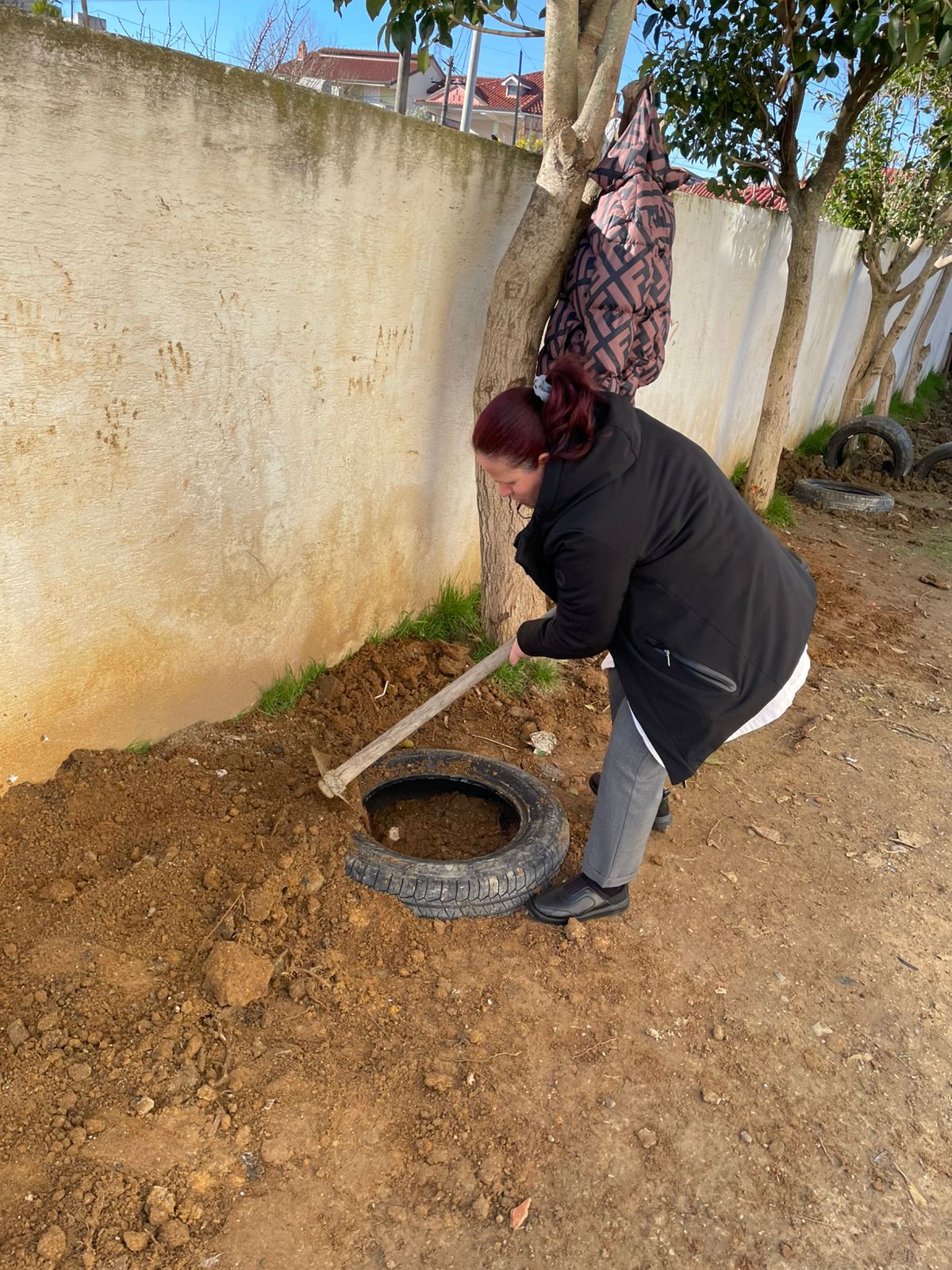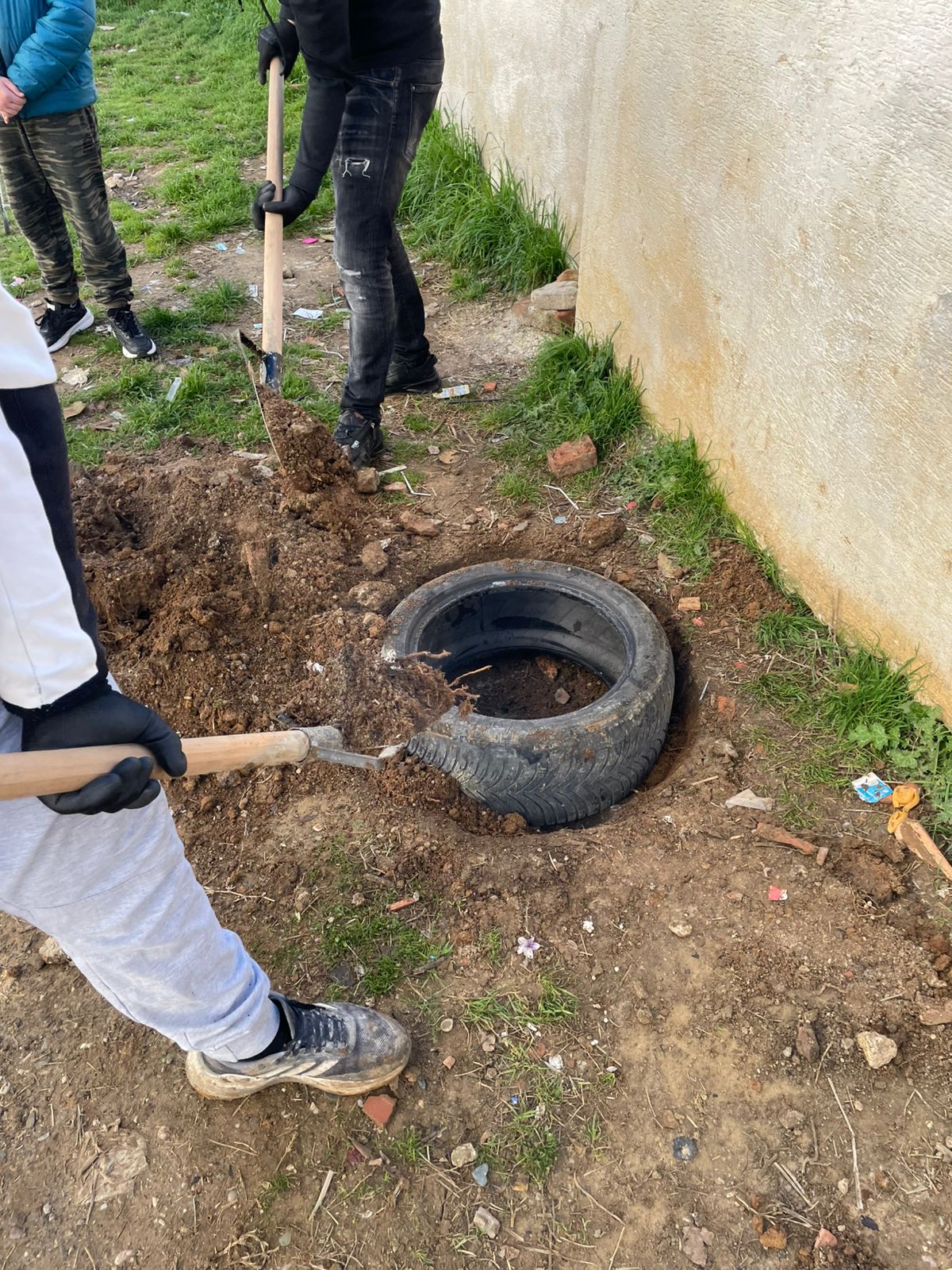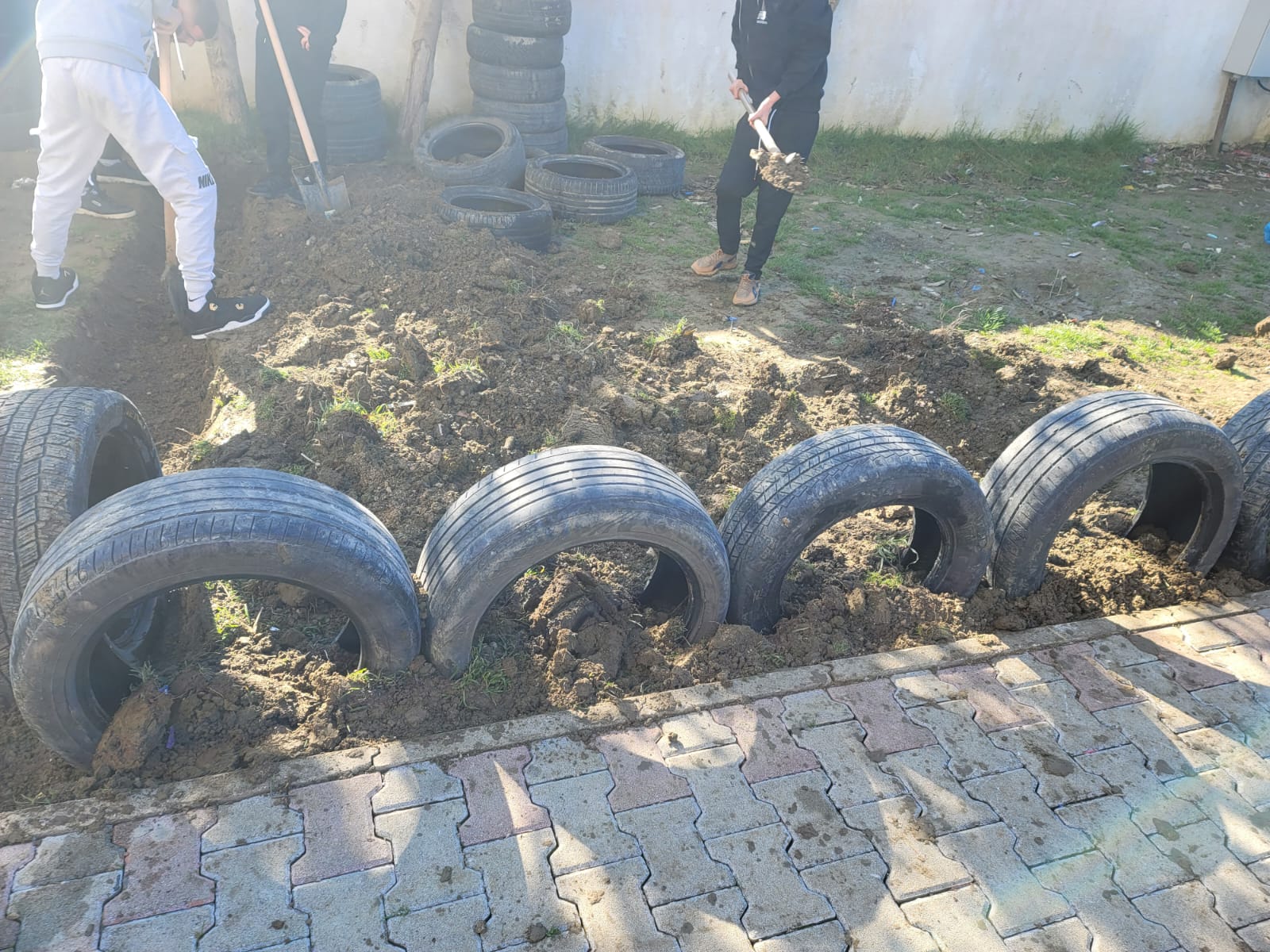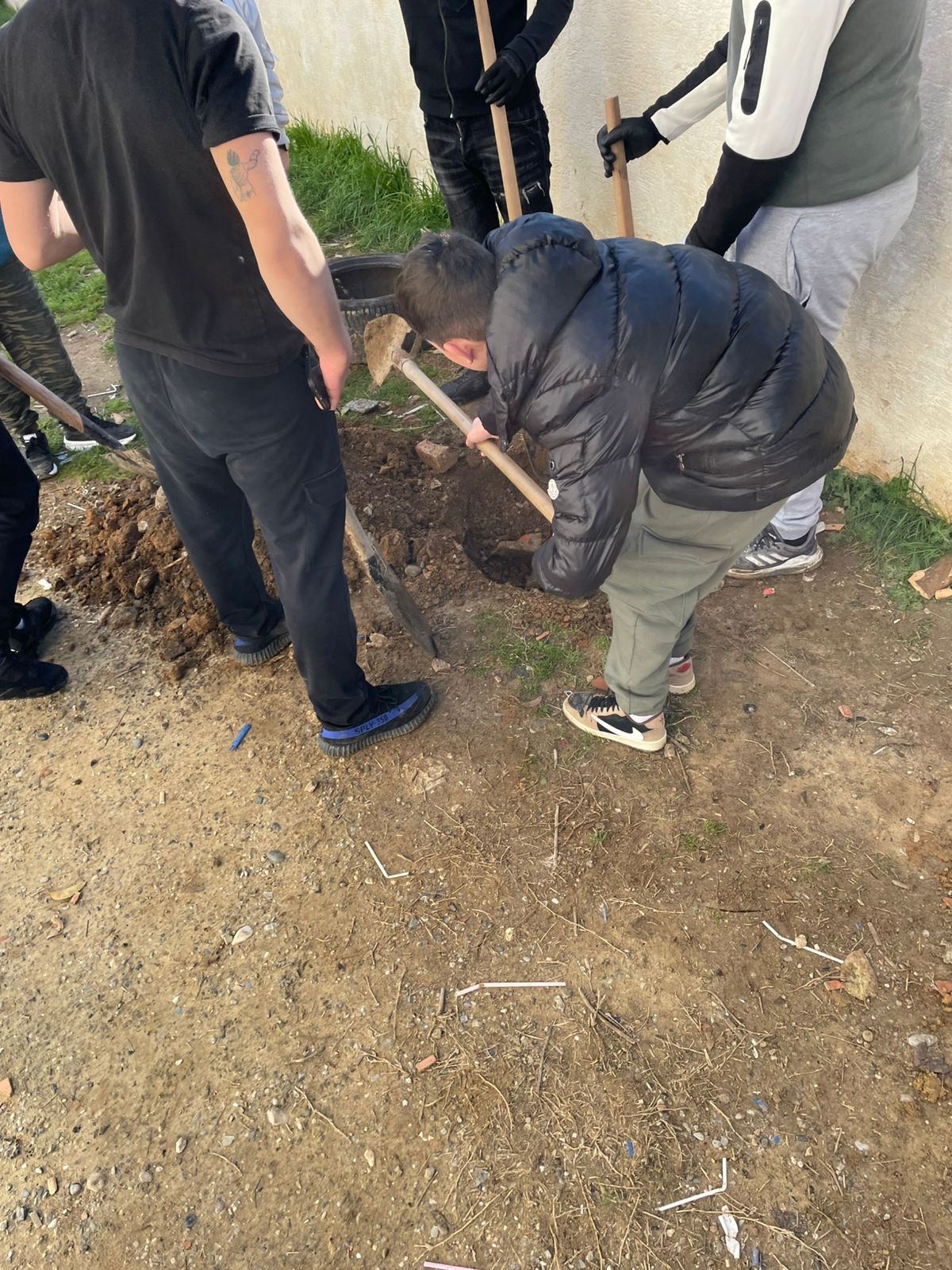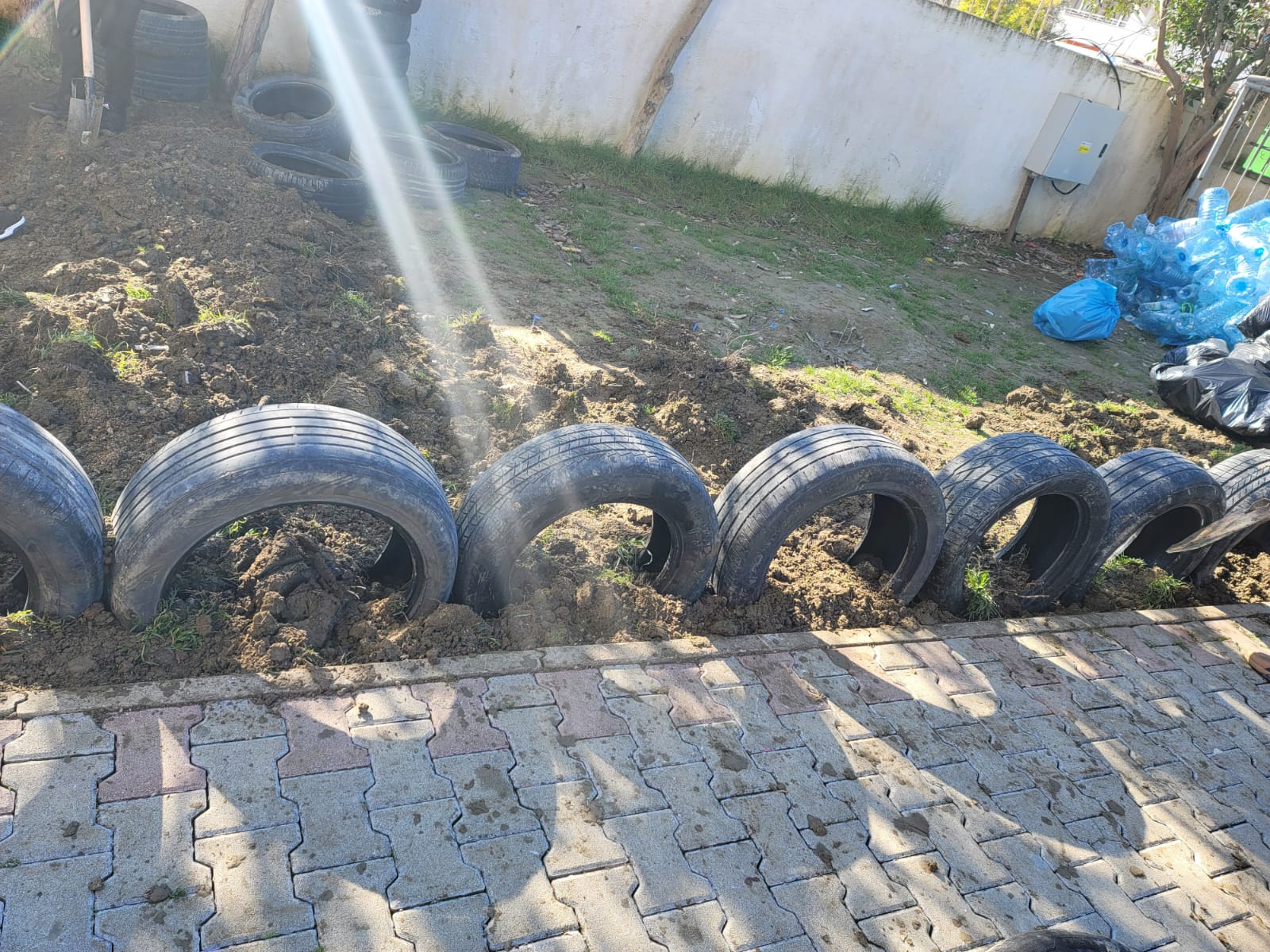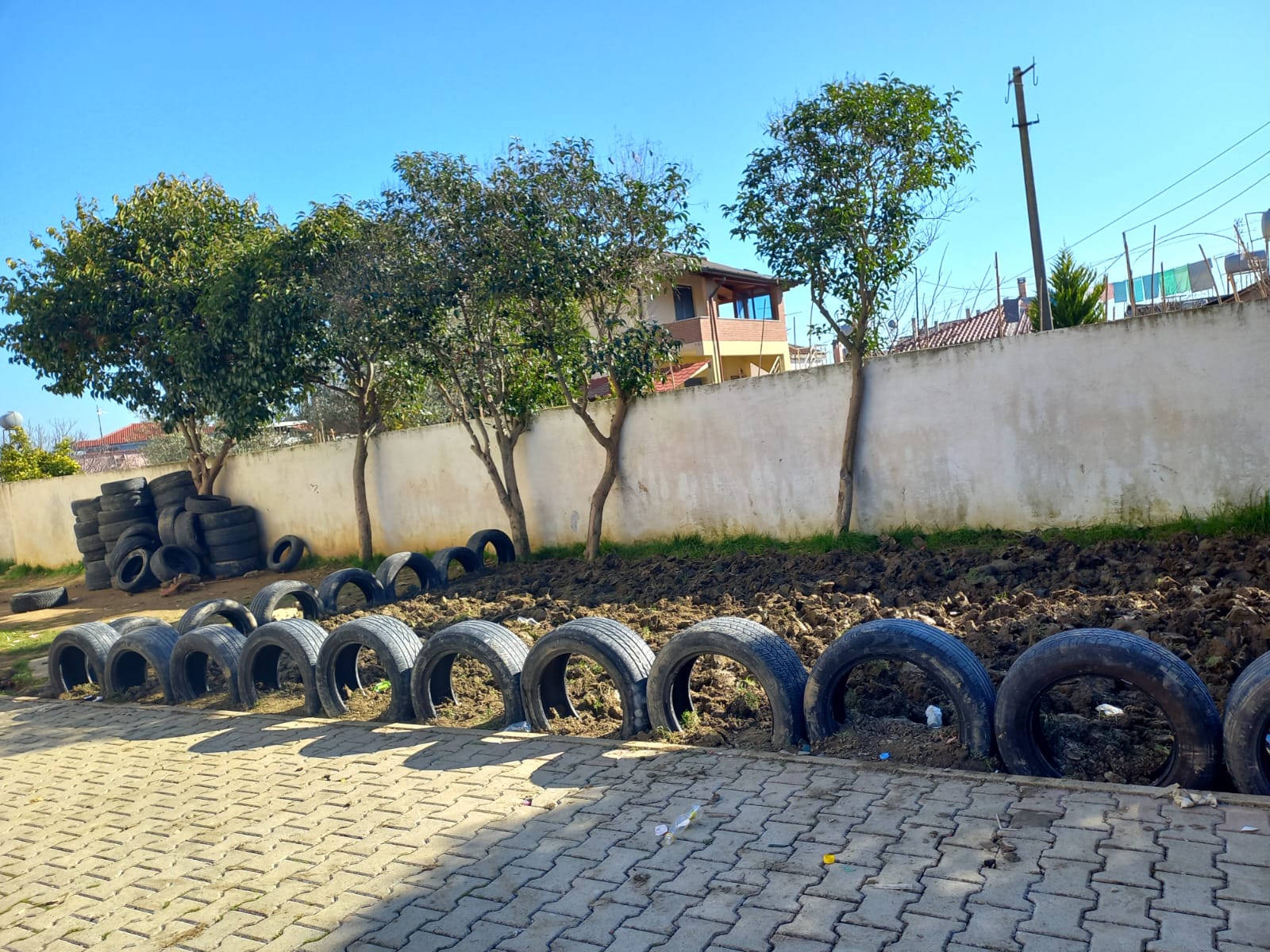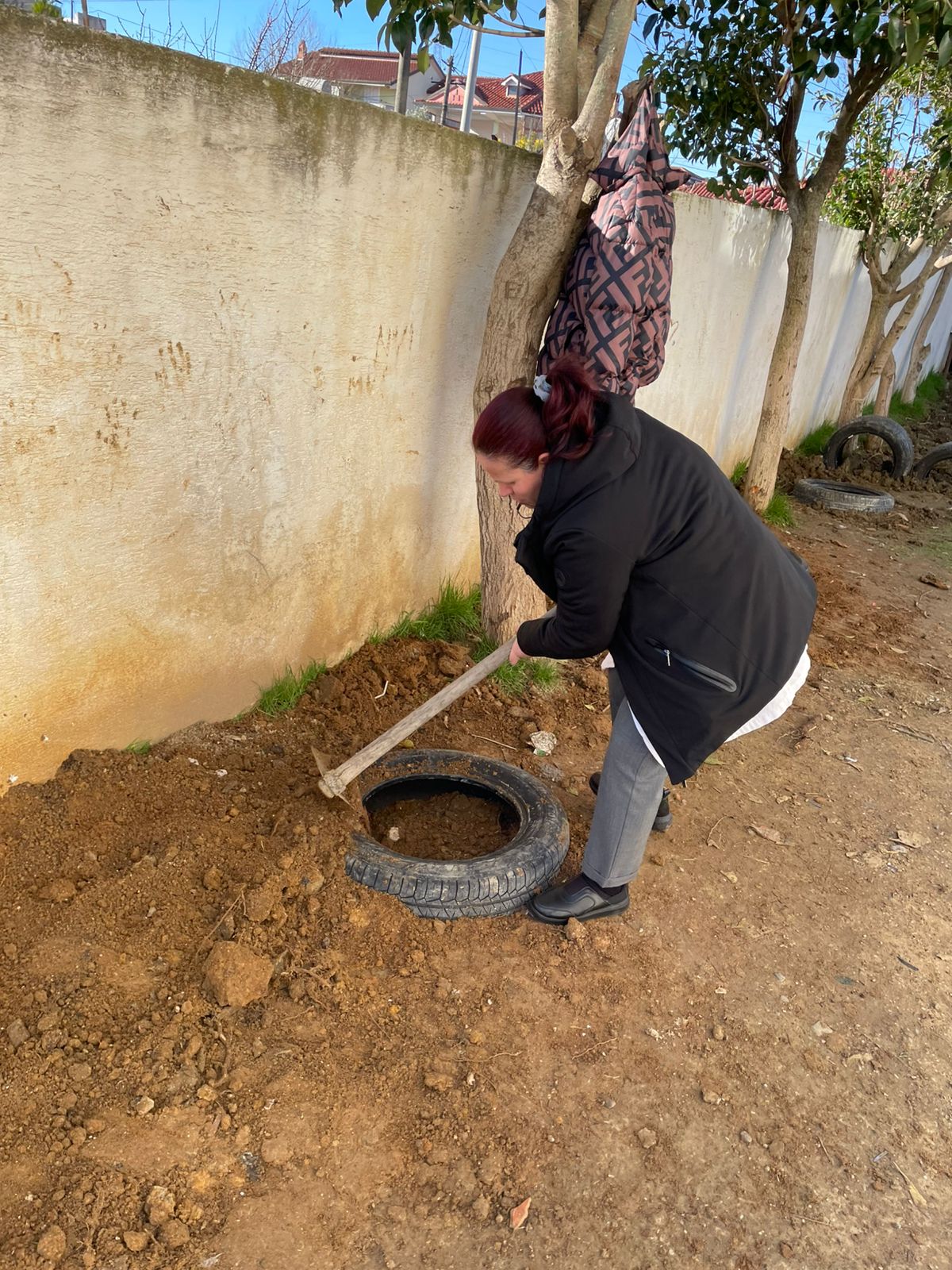Reconnecting with nature
The flower garden at our schoole
The school garden will help us contribute to environmental protection.
[15:21, 2/11/2025] Marnela: tributes to the co…
[15:41, 2/11/2025] Marnela: The project aims to engage students in caring for the environment. We ourselves are the cause of environmental pollution. Creating a small corner in our school where we plant flowers, trees and take care of them would enable a better quality education for students. The future is the new generations. Educating them with love for the environment will bring a change in the future. The garden in our school does not only aim
[15:41, 2/11/2025] Marnela: The project aims to engage students in caring for the environment. We ourselves are the cause of environmental pollution. Creating a small corner in our school where we plant flowers, trees and take care of them would enable a better quality education for students. The future is the new generations. Educating them with love for the environment will bring a change in the future. The garden in our school does not only aim
Albania
Local
Xhafzotaj, Durres
Mainly rural
It refers to a physical transformation of the built environment (hard investment)
Yes
2025-02-10
No
No
Yes
No
Yes
As an individual partnership with other persons/organisation(s)
The "Garden in School" project aims to create a green space where students engage in planting and caring for plants, integrating knowledge from science, biology and civic education.
📌 Main Goal:
Promoting environmental and sustainability education through practical experiences.
📌 Target Groups:
Primary and secondary school students.
Teachers and local community.
📌 Specific Objectives:
Improving knowledge on urban agriculture and biodiversity.
Raising awareness on sustainability and food security.
Improving students' mental well-being through interaction with nature.
📌 Achieved Results:
Creating a functional garden on school premises.
Using the garden as an educational laboratory for various subjects.
Engaging the community and parents in educational activities.
This project supports the values of the New European Bauhaus, integrating sustainability, aesthetics, and social inclusion into an innovative space that improves the lives of students and the community.
📌 Main Goal:
Promoting environmental and sustainability education through practical experiences.
📌 Target Groups:
Primary and secondary school students.
Teachers and local community.
📌 Specific Objectives:
Improving knowledge on urban agriculture and biodiversity.
Raising awareness on sustainability and food security.
Improving students' mental well-being through interaction with nature.
📌 Achieved Results:
Creating a functional garden on school premises.
Using the garden as an educational laboratory for various subjects.
Engaging the community and parents in educational activities.
This project supports the values of the New European Bauhaus, integrating sustainability, aesthetics, and social inclusion into an innovative space that improves the lives of students and the community.
Environmental Education
Sustainability
Innovation in Education
Mental Wellbeing
Community Engagement
The "Kindergarten in School" project embodies the three main values of the New European Bauhaus, creating a green educational space that promotes sustainability, aesthetics and inclusion.
✅ Sustainability:
The kindergarten is an educational model for sustainable agriculture and urban biodiversity.
Students learn about recycling, composting and the use of ecological materials.
The environmental impact is reduced by promoting green practices and climate awareness.
🎨 Beauty:
The kindergarten transforms the school environment into a more attractive and inspiring space.
It improves the aesthetic quality of the learning environment and creates a warmer and healthier atmosphere.
🤝 Social Inclusion:
Students, teachers and the local community work together in maintaining the garden.
The project encourages cooperation, responsibility and interaction between generations.
Various social groups are also involved to create a replicable model in other areas.
📌 How can it be a model to follow?
It can be implemented in other schools to educate new generations about ecology.
It offers a local solution to global challenges such as climate change and sustainable urbanization.
It creates an interdisciplinary education model by integrating subjects such as science, art and civic education.
✅ Sustainability:
The kindergarten is an educational model for sustainable agriculture and urban biodiversity.
Students learn about recycling, composting and the use of ecological materials.
The environmental impact is reduced by promoting green practices and climate awareness.
🎨 Beauty:
The kindergarten transforms the school environment into a more attractive and inspiring space.
It improves the aesthetic quality of the learning environment and creates a warmer and healthier atmosphere.
🤝 Social Inclusion:
Students, teachers and the local community work together in maintaining the garden.
The project encourages cooperation, responsibility and interaction between generations.
Various social groups are also involved to create a replicable model in other areas.
📌 How can it be a model to follow?
It can be implemented in other schools to educate new generations about ecology.
It offers a local solution to global challenges such as climate change and sustainable urbanization.
It creates an interdisciplinary education model by integrating subjects such as science, art and civic education.
1. Aesthetics and Quality of Experience
The "Garden in School" project improves learning spaces by transforming them into beautiful, inspiring and functional environments.
✅ How is this achieved?
The design of the garden is intended to create a visually appealing and pleasant environment for students.
The space includes natural elements, contributing to a richer and more relaxed educational experience.
Planting and maintaining plants helps develop aesthetic sensitivity and creativity in students.
📌 How can this project be a model?
It can serve as an example for the transformation of other educational spaces in a sustainable and aesthetic way.
It promotes the connection between design, culture and the natural environment, in line with the values of the New European Bauhaus.
The "Garden in School" project improves learning spaces by transforming them into beautiful, inspiring and functional environments.
✅ How is this achieved?
The design of the garden is intended to create a visually appealing and pleasant environment for students.
The space includes natural elements, contributing to a richer and more relaxed educational experience.
Planting and maintaining plants helps develop aesthetic sensitivity and creativity in students.
📌 How can this project be a model?
It can serve as an example for the transformation of other educational spaces in a sustainable and aesthetic way.
It promotes the connection between design, culture and the natural environment, in line with the values of the New European Bauhaus.
2. Social Inclusion
The project aims to be accessible and inclusive for all, creating a space for collaboration between students, teachers and the community.
✅ How is this achieved?
All students, regardless of their social background or abilities, are involved in practical activities.
The kindergarten is designed to be an inclusive space, ensuring that everyone has equal access.
The involvement of the community and parents creates a sense of belonging and shared responsibility.
📌 How can it serve as a model?
This project can be implemented in other schools, promoting inclusive education and social collaboration.
It shows how an educational space can be open and accessible to all, focusing on equality and equal opportunities.
The project aims to be accessible and inclusive for all, creating a space for collaboration between students, teachers and the community.
✅ How is this achieved?
All students, regardless of their social background or abilities, are involved in practical activities.
The kindergarten is designed to be an inclusive space, ensuring that everyone has equal access.
The involvement of the community and parents creates a sense of belonging and shared responsibility.
📌 How can it serve as a model?
This project can be implemented in other schools, promoting inclusive education and social collaboration.
It shows how an educational space can be open and accessible to all, focusing on equality and equal opportunities.
This project aims to create a garden within the school, where students are directly involved in planting and caring for flowers. What makes this initiative innovative is the combination of different teaching disciplines with practical experience in nature.
---
1. Cross-curricular integration
One of the main innovative aspects of the project is the integration of the school curriculum into practical gardening activities. Here is how some subjects can be linked:
Biology – Students learn about plants, their life cycle, photosynthesis, soil types and the influence of environmental factors on plant growth.
Chemistry – Learning about soil composition, plant nutrients, and the influence of natural and chemical fertilizers.
Mathematics – Calculating planting areas, irrigation amounts and fertilization ratios.
Language and Literature – Describing experiences in nature journals, writing essays or creating poems about nature.
Environmental Education – Raising awareness about the importance of biodiversity and human impact on the environment.
Technology and Design – Creating simple irrigation systems or urban gardening models.
This integration of theory with practice makes the learning process more engaging and efficient.
---
1. Cross-curricular integration
One of the main innovative aspects of the project is the integration of the school curriculum into practical gardening activities. Here is how some subjects can be linked:
Biology – Students learn about plants, their life cycle, photosynthesis, soil types and the influence of environmental factors on plant growth.
Chemistry – Learning about soil composition, plant nutrients, and the influence of natural and chemical fertilizers.
Mathematics – Calculating planting areas, irrigation amounts and fertilization ratios.
Language and Literature – Describing experiences in nature journals, writing essays or creating poems about nature.
Environmental Education – Raising awareness about the importance of biodiversity and human impact on the environment.
Technology and Design – Creating simple irrigation systems or urban gardening models.
This integration of theory with practice makes the learning process more engaging and efficient.
2. Learning by Doing
Unlike the traditional method of learning through books and tables, this project offers an opportunity for learning through action and experience. Through practical engagement, students will learn not only how plants grow, but also how to work in a group, organize work and take responsibility.
---
3. Development of Soft Skills
The project helps students develop important skills such as:
✅ Collaboration – Working in a group to care for plants.
✅ Responsibility – Taking care of the garden regularly.
✅ Creativity – Designing green spaces and combining flowers.
✅ Problem Solving – Finding solutions to challenges in growing plants.
---
4. Positive impact on emotional and psychological well-being
Studies show that contact with nature helps reduce stress and improve mental health. Through this project, students will have an opportunity to spend more time outdoors and experience a more relaxing and healthy environment.
Unlike the traditional method of learning through books and tables, this project offers an opportunity for learning through action and experience. Through practical engagement, students will learn not only how plants grow, but also how to work in a group, organize work and take responsibility.
---
3. Development of Soft Skills
The project helps students develop important skills such as:
✅ Collaboration – Working in a group to care for plants.
✅ Responsibility – Taking care of the garden regularly.
✅ Creativity – Designing green spaces and combining flowers.
✅ Problem Solving – Finding solutions to challenges in growing plants.
---
4. Positive impact on emotional and psychological well-being
Studies show that contact with nature helps reduce stress and improve mental health. Through this project, students will have an opportunity to spend more time outdoors and experience a more relaxing and healthy environment.
The methodology used in this project can be applied in different educational and community contexts. It includes:
✅ Integrated Learning – Linking gardening with different teaching subjects (biology, mathematics, language, technology, environmental education).
✅ Learning by Doing – Involving students in the process of planting, caring for and monitoring plants, promoting learning through experience.
✅ Collaborative Learning – Working in groups to promote cooperation, division of tasks and the development of social skills.
✅ Problem-Based Learning (PBL) – Involving students in finding solutions to challenges such as saving water, using natural fertilizers, or designing a sustainable gardening system.
Replicability:
This methodology can be used not only in schools, but also in community centers, youth groups and organizations that promote environmental education.
---
✅ Integrated Learning – Linking gardening with different teaching subjects (biology, mathematics, language, technology, environmental education).
✅ Learning by Doing – Involving students in the process of planting, caring for and monitoring plants, promoting learning through experience.
✅ Collaborative Learning – Working in groups to promote cooperation, division of tasks and the development of social skills.
✅ Problem-Based Learning (PBL) – Involving students in finding solutions to challenges such as saving water, using natural fertilizers, or designing a sustainable gardening system.
Replicability:
This methodology can be used not only in schools, but also in community centers, youth groups and organizations that promote environmental education.
---
2. Applicable Technology and Techniques
This project involves the use of sustainable technology and techniques that can be replicated in other places:
🔹 Sustainable Irrigation Systems – Using drip irrigation to minimize water loss, an easy technique to implement in different places.
🔹 Composting – Creating natural fertilizers from school or home organic waste, a method that can be adopted by any community.
🔹 Use of indigenous plants – Selecting native plants to ensure sustainability and easier maintenance.
🔹 Tracking and documenting plant growth through technology – Using apps or digital boards to record data on plant growth and their conditions.
Replicability:
These technologies can be used not only in schools, but also in urban settings (rooftop gardening), community parks, or environmental education initiatives in rural and urban areas.
---
This project involves the use of sustainable technology and techniques that can be replicated in other places:
🔹 Sustainable Irrigation Systems – Using drip irrigation to minimize water loss, an easy technique to implement in different places.
🔹 Composting – Creating natural fertilizers from school or home organic waste, a method that can be adopted by any community.
🔹 Use of indigenous plants – Selecting native plants to ensure sustainability and easier maintenance.
🔹 Tracking and documenting plant growth through technology – Using apps or digital boards to record data on plant growth and their conditions.
Replicability:
These technologies can be used not only in schools, but also in urban settings (rooftop gardening), community parks, or environmental education initiatives in rural and urban areas.
---
This project follows some clear steps, which can be transferred and replicated in other places:
🔹 Planning and designing the garden – Choosing the location, plant types and dividing the tasks among the students.
🔹 Planting and caring for the plants – Daily care, measuring growth and analyzing the environmental factors that influence their development.
🔹 Monitoring and documentation – Keeping a diary or using a digital platform to track progress.
🔹 Community interaction – Organizing events, exhibitions or plant sales to raise environmental awareness and involve parents and the community.
Replicability:
This process can be implemented in any school, community center, public garden and environmental initiative, with minor modifications according to the context.
---
4. Project Products and Results
This project produces several concrete products, which can be transferred and replicated in other countries:
🌿 A sustainable and functional garden – Which can be used as an open laboratory for learning.
📗 Manuals and guides for students and teachers – To explain the processes of planting, caring for plants and best practices for environmental sustainability.
📊 Reports and studies on the impact of the project – Which can help in the application of similar projects in other schools.
🎭 Awareness-raising events and activities – Such as fairs, competitions and open days where the community is invited to see the progress.
Replicability:
These products can be used for other schools, environmental organizations, or educational projects in different countries.
🔹 Planning and designing the garden – Choosing the location, plant types and dividing the tasks among the students.
🔹 Planting and caring for the plants – Daily care, measuring growth and analyzing the environmental factors that influence their development.
🔹 Monitoring and documentation – Keeping a diary or using a digital platform to track progress.
🔹 Community interaction – Organizing events, exhibitions or plant sales to raise environmental awareness and involve parents and the community.
Replicability:
This process can be implemented in any school, community center, public garden and environmental initiative, with minor modifications according to the context.
---
4. Project Products and Results
This project produces several concrete products, which can be transferred and replicated in other countries:
🌿 A sustainable and functional garden – Which can be used as an open laboratory for learning.
📗 Manuals and guides for students and teachers – To explain the processes of planting, caring for plants and best practices for environmental sustainability.
📊 Reports and studies on the impact of the project – Which can help in the application of similar projects in other schools.
🎭 Awareness-raising events and activities – Such as fairs, competitions and open days where the community is invited to see the progress.
Replicability:
These products can be used for other schools, environmental organizations, or educational projects in different countries.
The school garden project is a simple and effective solution to many global challenges, offering a replicable model at the local level.
🌍 Addresses global challenges such as:
✔ Climate change and environmental degradation.
✔ Food security and lack of knowledge about agriculture.
✔ Quality education and lack of innovative learning methods.
✔ Children's mental health and the need for well-being.
✔ Increasing green spaces in cities and sustainability.
🏡 Local solutions through the project:
✅ Education on agriculture and sustainability.
✅ Creating quiet and relaxing spaces in schools.
✅ Promoting innovative learning methods.
✅ Improving children's psychological well-being.
✅ Transforming schools into green education centers.
💡 This project can become a model for other schools and communities, helping to create a generation more aware and prepared for the challenges of the future.
🌍 Addresses global challenges such as:
✔ Climate change and environmental degradation.
✔ Food security and lack of knowledge about agriculture.
✔ Quality education and lack of innovative learning methods.
✔ Children's mental health and the need for well-being.
✔ Increasing green spaces in cities and sustainability.
🏡 Local solutions through the project:
✅ Education on agriculture and sustainability.
✅ Creating quiet and relaxing spaces in schools.
✅ Promoting innovative learning methods.
✅ Improving children's psychological well-being.
✅ Transforming schools into green education centers.
💡 This project can become a model for other schools and communities, helping to create a generation more aware and prepared for the challenges of the future.
This project follows some clear steps, which can be transferred and replicated in other places:
🔹 Planning and designing the garden – Choosing the location, plant types and dividing the tasks among the students.
🔹 Planting and caring for the plants – Daily care, measuring growth and analyzing the environmental factors that influence their development.
🔹 Monitoring and documentation – Keeping a diary or using a digital platform to track progress.
🔹 Community interaction – Organizing events, exhibitions or plant sales to raise environmental awareness and involve parents and the community.
Replicability:
This process can be implemented in any school, community center, public garden and environmental initiative, with minor modifications according to the context.
---
4. Project Products and Results
This project produces several concrete products, which can be transferred and replicated in other countries:
🌿 A sustainable and functional garden – Which can be used as an open laboratory for learning.
📗 Manuals and guides for students and teachers – To explain the processes of planting, caring for plants and best practices for environmental sustainability.
📊 Reports and studies on the impact of the project – Which can help in the application of similar projects in other schools.
🎭 Awareness-raising events and activities – Such as fairs, competitions and open days where the community is invited to see the progress.
Replicability:
These products can be used for other schools, environmental organizations, or educational projects in different countries.
🔹 Planning and designing the garden – Choosing the location, plant types and dividing the tasks among the students.
🔹 Planting and caring for the plants – Daily care, measuring growth and analyzing the environmental factors that influence their development.
🔹 Monitoring and documentation – Keeping a diary or using a digital platform to track progress.
🔹 Community interaction – Organizing events, exhibitions or plant sales to raise environmental awareness and involve parents and the community.
Replicability:
This process can be implemented in any school, community center, public garden and environmental initiative, with minor modifications according to the context.
---
4. Project Products and Results
This project produces several concrete products, which can be transferred and replicated in other countries:
🌿 A sustainable and functional garden – Which can be used as an open laboratory for learning.
📗 Manuals and guides for students and teachers – To explain the processes of planting, caring for plants and best practices for environmental sustainability.
📊 Reports and studies on the impact of the project – Which can help in the application of similar projects in other schools.
🎭 Awareness-raising events and activities – Such as fairs, competitions and open days where the community is invited to see the progress.
Replicability:
These products can be used for other schools, environmental organizations, or educational projects in different countries.
The school garden project has had a significant impact in several categories, including education, well-being, environment and sustainable development. Below are the main results achieved, benefits for beneficiaries and long-term impact.
📌 The school garden project has created a successful model that can be replicated and adapted in other schools, bringing numerous benefits to students, teachers, families and the community.
📌 Its impact extends beyond the school, helping to build a generation aware of the environment, healthy eating and sustainable development.
💡 This project is not only an educational initiative, but an investment in the green future of the younger generations!
📌 The school garden project has created a successful model that can be replicated and adapted in other schools, bringing numerous benefits to students, teachers, families and the community.
📌 Its impact extends beyond the school, helping to build a generation aware of the environment, healthy eating and sustainable development.
💡 This project is not only an educational initiative, but an investment in the green future of the younger generations!

